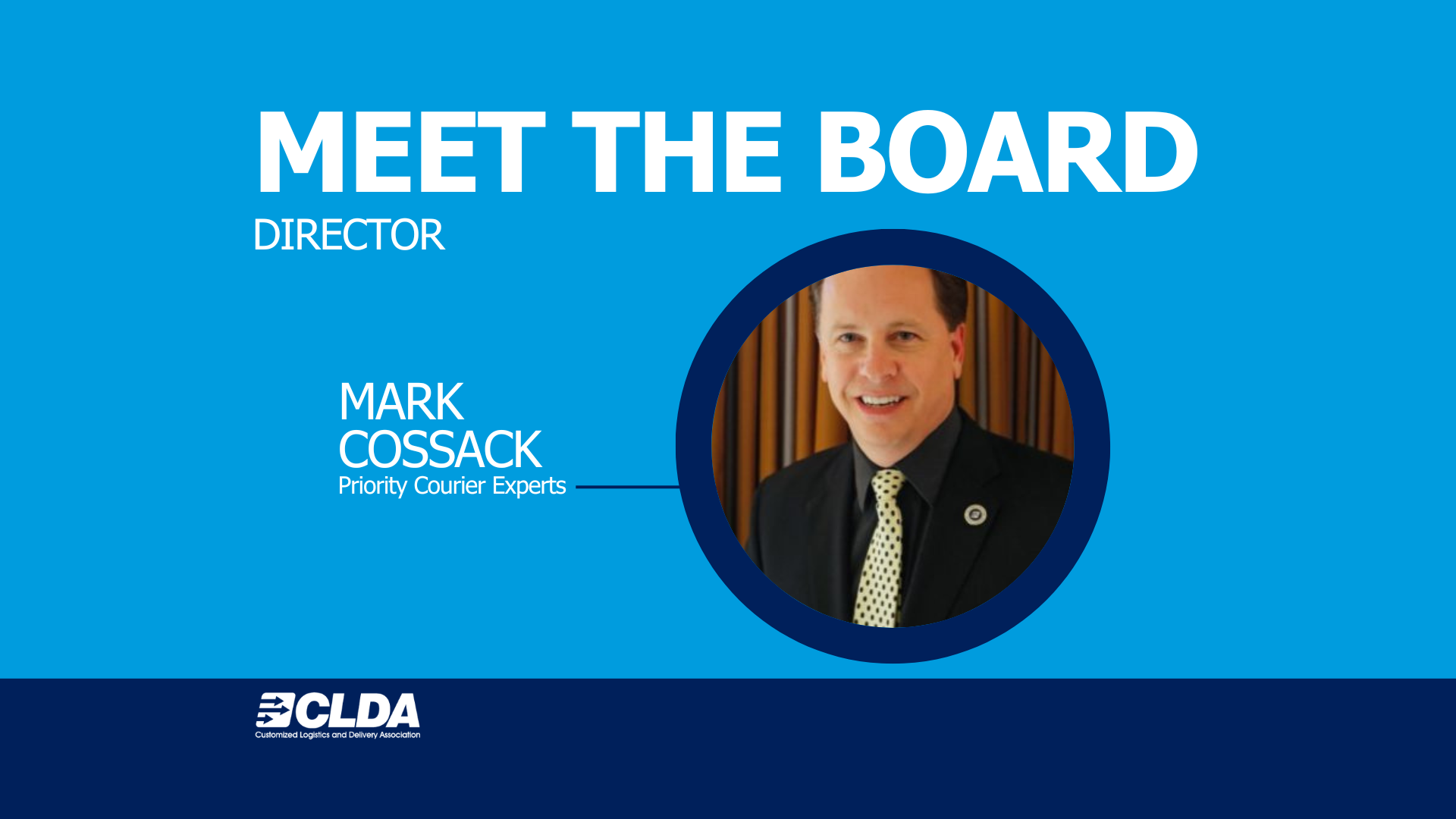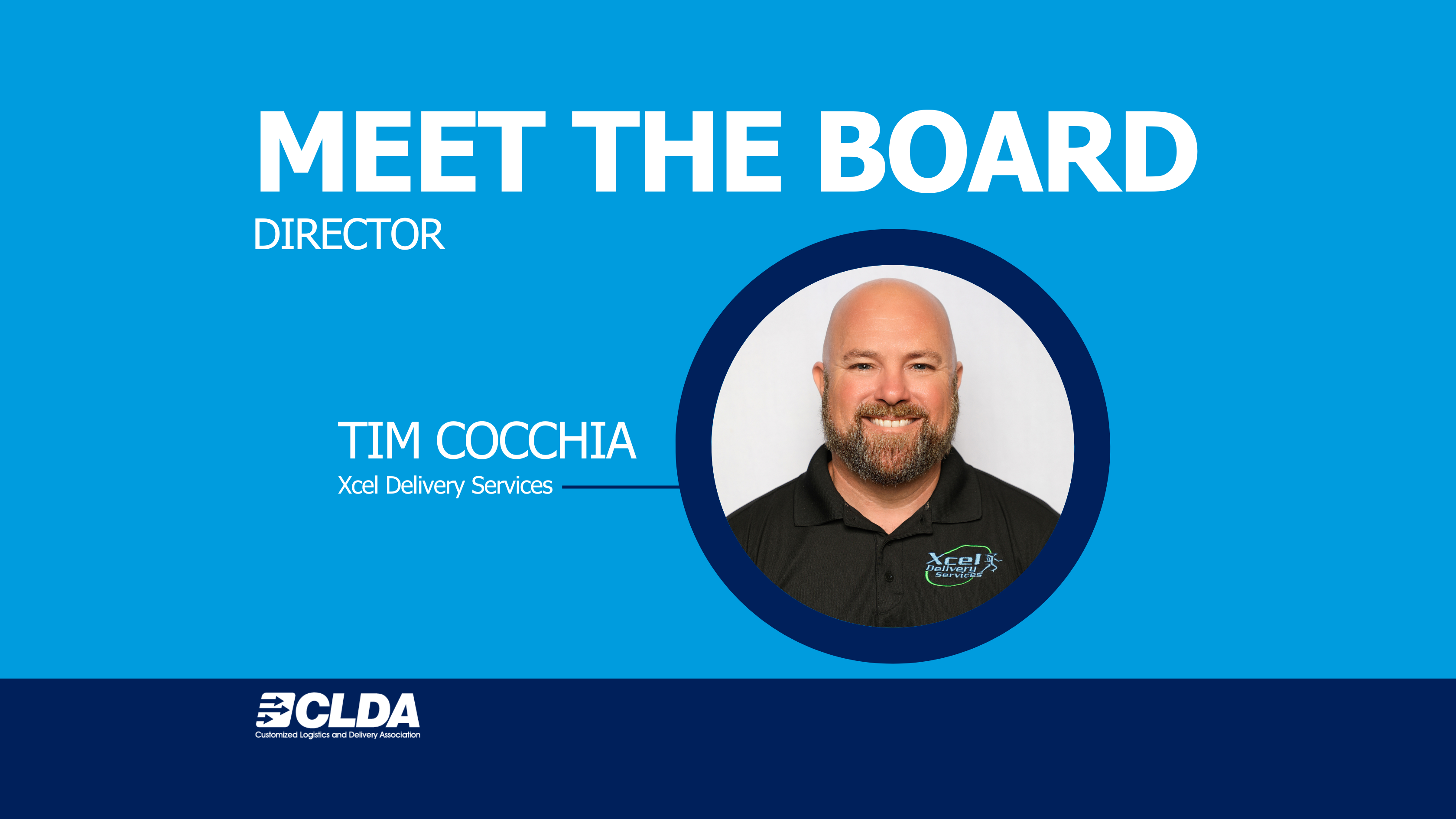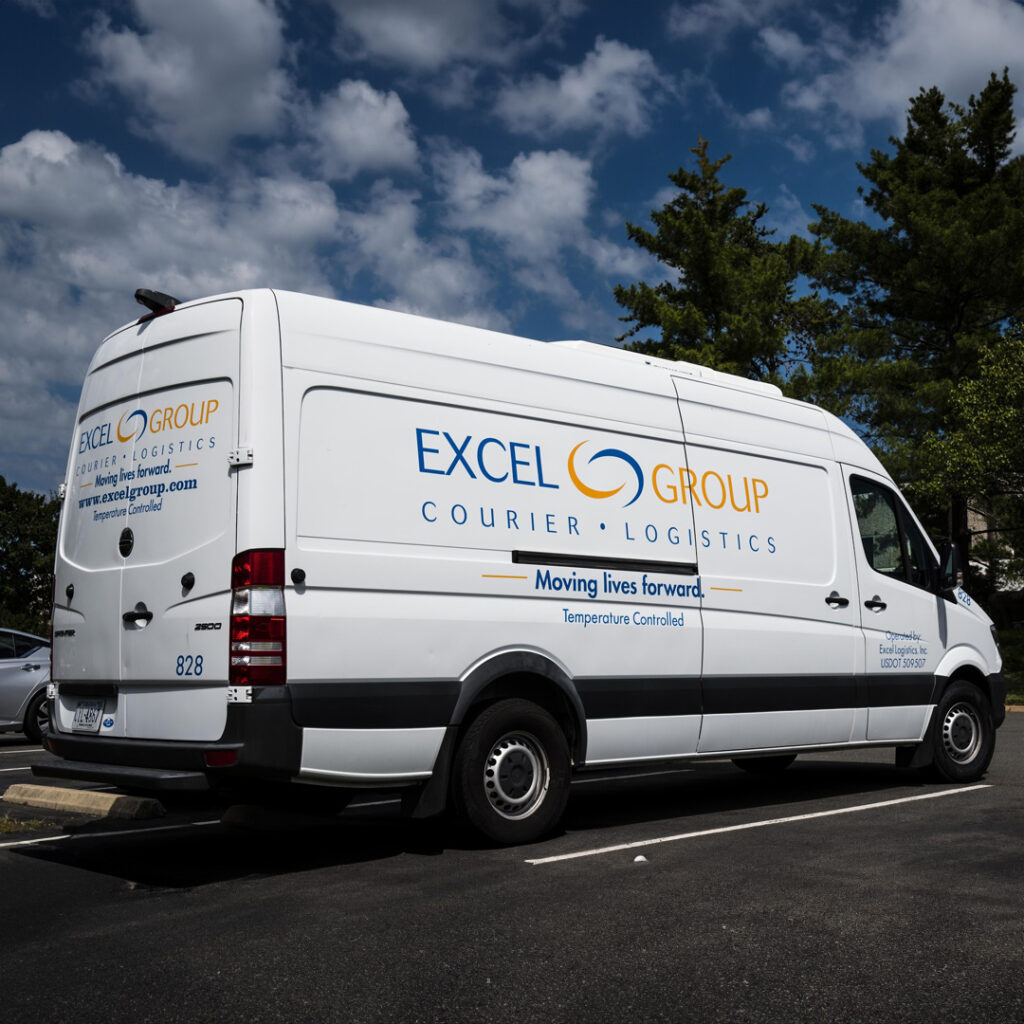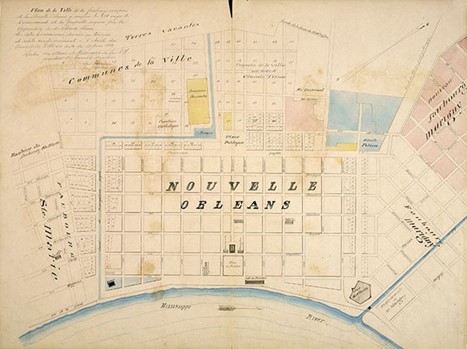
Home | News






CLDA Members are encouraged to share news about their company. CLDA may share on social media, in newsletters or on the website.

Ready to share your news with CLDA or the industry media? Learn from these tips and tricks on how to get noticed.

Indianapolis, IN, March 27, 2024 — Joel Pinsky was recently elected president of the Customized Logistics & Delivery Association (CLDA). Pinsky is the CEO and CFO of Global Messenger and Logistics. The election took place in December and newly elected positions took office at the CLDA’s Final Mile Forum.
Three new board members were also elected to the Board of Directors and took office at that meeting:
Pinsky has been involved with the CLDA since 2010, serving on multiple committees, including Member Benefits, Membership, Vendors, Final Mile Forum, Government Affairs, Final Mile Focus, and its predecessor, the Executive Leadership Summit. He has been a member of the association’s Board of Directors since 2017.
“I joined my first committee and then the Board of Directors because I wanted to give back to the logistics industry,” he says. “This association has provided networking and educational opportunities that helped my business and me get to where we are today. As President, I hope to lead the CLDA onward and upward so that the diverse members of our industry can receive the opportunities I have been lucky enough to have.”
The Customized Logistics and Delivery Association (CLDA) represents the first to final miles of the supply chain in the US and worldwide. This non-profit professional association serves the needs of its 2,900 essential service members: logistics professionals, carriers, shippers, drivers, air cargo logistics providers, 3PLs, and vendors servicing today’s supply chain companies. The CLDA gives its members access to a diverse network of logistics professionals looking to create new business opportunities and share decades of practical insights. They provide an avenue for amplifying members’ voices on critical issues and help them participate in the regulatory discussions shaping the industry. The CLDA keeps members informed and educated on trends, current issues, and best practices. For more information, see clda.org.
Media Contact
Andrea Obston
aobston@aomc.com
INDIANAPOLIS, IN, Feb. 26, 2024 — Mary Ann B. Passi, CAE, has been appointed Executive Director of the Customized Logistics & Delivery Association (CLDA).
She brings her more than 30 years of association management experience to this position. For the past 22 years, she has been the Chief Executive Officer of the Corporate Housing Providers Association (CHPA). She has also held leadership positions in the Society of Nutrition Education & Behavior, the Society of Nutrition Education & Behavior Foundation, the Association of Fundraising Professionals – Chicago, the Advocate Healthcare Foundation, the Women’s Council of Realtors©, the Association of Women Surgeons and the Computer Measurement Group.
Passi was recently honored with the Industry Impact Award by the Corporate Housing Providers. She is the only non-member of the association to receive this honor. In 2022 she was recognized as the Executive of the Year by the Indiana Society of Association Executives. Passi has been a Certified Association Executive (CAE) since 1997. She is a member of the American Society of Association Executives, the Indiana Society of Association Executives, and the Association Forum.
“Mary Ann’s breadth of experience in guiding international professional member societies, leading fundraising efforts, and managing operations impressed us,” says CLDA’s newly elected president, Joel Pinsky. “Under her leadership, these associations increased membership, revenue, and the impact they had. That made her a perfect fit for CLDA’s ambitious goals. We are pleased to have her aboard.”
Passi is part of the senior leadership team at the association management company Raybourn Group International (RGI). RGI’s Vice President of Association Strategies, Mark McSweeney, CAE, has held the post of Interim Executive Director since the group assumed management of CLDA in 2023. RGI is an accredited full-service Association Management Company. The organization has managed associations with members in 107 countries that serve over 60,000 members. Headquartered in Indianapolis, RGI is one of just 15% of association management companies accredited by the AMC Institute. Since 1988, they have worked with trade and professional associations, individual membership societies, foundations, nonprofits, and other membership-based organizations worldwide.
To see the newly-released rule, go to https://www.federalregister.gov/d/2024-00067.
INDIANAPOLIS, IN, Jan. 16, 2024 — On January 9, the Department of Labor (DOL) issued the final version of the rule to determine whether a worker is an employee or independent contractor (IC) under the Fair Labor Standards Act (FLSA). In this version of the rule, the DOL’s definition of an IC has shifted to a more employee-slanted one. Past administrations have defined IC status using two primary factors – opportunity for profit and loss and control – and four secondary factors. In the DOL’s new interpretation, that decision will be based on all six factors, making it more likely that an IC will be deemed to be an employee.
“This interpretation is slanted in favor of finding employee status and particularly unfair to the delivery and trucking industries,” says Mark Cossack, head of Government Affairs at the Customized Logistics & Delivery Association. “We took this issue head-on, mobilizing our 2,900 members, many of whom rely on independent contractors. We vigorously lobbied against the changes in both written and in-person avenues. There was also an outcry from other industries that use ICs. As a result, the January 9 release of the rule has been changed. These came about because of our association’s aggressive in-person and written efforts to actively engage with the Office of Management and Budget (OMB) and the DOL, respectively, to outline the position of our members. It represents a slight softening of the rule that was initially proposed. That original version would have severely restricted the use of ICs under federal minimum wage and overtime laws.”
Cossack pointed out that this rule change does not signal the end of this contentious issue. “This is just another step towards a realistic and complete definition of an IC on the federal level,” says Cossack. “We will continue to advocate for litigation challenging the rule and federal legislation adequately defining an IC.”
The association is currently organizing a trip to Washington, DC, to meet with legislators to explain the need for a formal and realistic definition of an IC. “The fight is not over. We need the help and financial support of every business that depends on ICs to meet customer demands. We can’t do this alone,” says Cossack.
The rule is scheduled to be implemented on March 11, 2024. The changes included as a result of our lobbying efforts include:
“These changes are more positive than the DOL’s originally proposed rules,” says Cossack. “The version the department originally proposed would have severely restricted the use of ICs under federal minimum wage and overtime laws. Nevertheless, it still makes using ICs to respond to customers’ needs more difficult than it was previously. The definition of an IC is still very convoluted. This rule puts a complicated six-pronged economic realities test in place that determines whether an individual is an employee or an independent contractor. The DOL has the full discretion to enforce this test, and its interpretation depends upon the facts and circumstances of each case.”
The new rule change is not the final word on the definition of an independent contractor and sets up another round of challenges from those depending on ICs. “The rule will be challenged in the courts,” predicts Cossack, pointing to others already joining the association’s fight. “The Coalition for Workforce Innovation (CWI) already has a pending case before the 5th Circuit Court of Appeals challenging the withdrawal of the independent contractor rule issued by the Trump administration. It is also possible the American Trucking Association (ATA) and companies like Uber and Lyft will challenge this rule in the courts. In addition, we will be reaching out to the individuals we formerly met at the Office of Management and Budget (OMB), Office of Information and Regulatory Affairs (OIRA), and the DOL. We appreciate that they listened to some of the objections we raised in our past meetings and made changes that moved the rule in the direction CLDA recommended. But we will emphasize that more revisions must be made to make it a workable regulation to keep the wheels of commerce moving.”
To see the newly-released rule, go to https://www.federalregister.gov/d/2024-00067.
About The CLDA
The Customized Logistics and Delivery Association (CLDA) represents the first to final miles of the supply chain in the US and worldwide. This non-profit professional association serves the needs of its 2,900 essential service members: logistics professionals, carriers, shippers, drivers, air cargo logistics providers, 3PLs, and vendors servicing today’s supply chain companies. The CLDA gives its members access to a diverse network of logistics professionals looking to create new business opportunities and share decades of practical insights. They provide an avenue for amplifying members’ voices on critical issues and help them participate in the regulatory discussions shaping the industry. The CLDA keeps members informed and educated on trends, current issues, and best practices. For more information, see clda.org.
Media Contact
Andrea Obston
aobston@aomc.com
(860) 803-1155

The event will kick off with a keynote about the importance of strategic planning in 2024. This will be followed by two rounds of Round Tables focusing on one of four verticals expected to grow in 2024. During these sessions, participants will be able to tap into the expertise of seasoned professionals and uncover their best-kept secrets, empowering them to assess opportunities in these high-potential areas. The workshop will end with a chance to discuss what they’ve learned and get a preview of activities planned for them by the CLDA.
Registration and sponsorship opportunities are available now. There are discounts for CLDA members and groups of three or more from the same company.
About The CLDA
The Customized Logistics and Delivery Association (CLDA) represents the first to final miles of the supply chain in the US and worldwide. This non-profit professional association serves the needs of its 2,900 essential service members: logistics professionals, carriers, shippers, drivers, air cargo logistics providers, 3PLs, and vendors servicing today’s supply chain companies. The CLDA gives its members access to a diverse network of logistics professionals looking to create new business opportunities and share decades of practical insights. They provide an avenue for amplifying members’ voices on critical issues and help them participate in the regulatory discussions shaping the industry. The CLDA keeps members informed and educated on trends, current issues, and best practices.
Media Contact
Andrea Obston
(860) 803-1155
Hello again, my CLDA and Industry colleagues,
We are in the home stretch of this year’s CLDA Final Mile Forum. With only 4 weeks to go until we gather at the Hyatt Regency in New Orleans, you should be getting fired up – a blazing fire (probably a bad pun and segue into today’s CRESCENT CITY CULTURE, as you will learn). However, if you HAVE NOT registered yet, remember that it will be MARDI GRAS, and our hotel block ends THIS MONDAY, January 16th. Let’s use them and not lose them.
Over the last few weeks, I have brought a New Orleans vibe to you by sharing some of New Orleans’ culture and introducing you to some of the personalities who have left an impression on and within New Orleans. There were, and are, some unique individuals that have shaped the landscape of your city and state. To say that we have had some unique characters here is an understatement. You could look to our politicians whose stories and antics could provide enough material for a good fiction novel, except that many of them happen to be TRUE. Meet two of these colorful characters – The Governor and the Stripper. And a little sidebar story relates to me and my quest to find a name for our company. I think you will connect those dots shortly.
Earl K. Long was the Governor of Louisiana for three separate terms; he was the younger brother of one of our other Governors, “The Kingfish” Huey Long. He got his taste for politics by campaigning for his older brother. Both were very flamboyant men.
When Earl Long returned to the top spot in Louisiana in 1948, he was known for many things. “Uncle Earl,” as he was called, was known for his advocacy for the “common man” and his entertaining behavior. His rambling “all over the map” one-hour speeches were also a trademark of Uncle Earl, and he even spent some time in a mental institution towards the end of his last term. But there was one other thing that this flamboyant man was known for…his open affair with Fannie Belle Fleming, better known as Bourbon Street burlesque dancer Blaze Starr.

As her fame grew, she traveled around the country, eventually finding a new home in New Orleans, specifically at the Sho-Bar on Bourbon Street. It was 1959 when a married Earl Long and company walked into the Bar. Long was so taken by her beauty that upon the conclusion of her act, he went to her dressing room and asked her out to dinner. The romance began. Long was not timid about his relationship with Starr, although he never did get divorced from “Miss Blanche,” his wife.
Blaze Starr was loved by many. Her glamour, combined with a man in his 60’s trying to reinvent his life, led to this unusual and unique love affair. Blaze Starr’s memoir, written in 1974, led to the 1989 movie about her life and romance with Governor Earl K Long… “Blaze” starring Paul Newman as Uncle Earl.
Here is a little more about the romance between the Governor and the Stripper.
I think you have connected those dots, but one night in 1991, my quest for a name for our company culminated with us popping a “tape” into our VCR (Remember those). I was looking for a name for our courier division to separate it from some of the other types of transportation services we were offering, thus giving that division its own identity. What we call today re-branding. I wanted the new name to depict speed and yet still be able to tie it to our main company and logo. After going thru all of the typical “express” and “fast” names, I was at a loss. Then on that night in 1991, after deciding to chill at the house, the opening marque shined on our TV – “Blaze.” My lightbulb finally lit up.
February 9th will be here soon, so make your plans NOW to join us in the Big Easy and learn more about our unique characters as you experience the CRESCENT CITY CULTURE!
See you in four weeks!

McSweeney has been with RGI for 10 years and has served in CEO capacities for 29 years, including national and international trade associations. He is a Certified Association Executive and received the Executive of the Year award from the Indiana Society of Association Executives. He is an active member of the American Society of Association Executives, Indiana Society of Association Executives, and Association Societies Alliance.
“We look forward to working with Mark and the rest of the RGI team,” said Jason Burns, CLDA’s president. “We chose to work with them because of their impressive record of growing membership, member engagement, member retention and the net assets of the associations they manage. We were particularly struck by their track record of increasing membership among those ages 18 to 40 by 60% over the last five years. These younger members of our last-mile community are the future of our industry and our association.”
RGI is an accredited full-service Association Management Company. The organization has managed associations with members in 107 countries that serve over 60,000 members. Headquartered in Indianapolis, RGI is one of just 15% of association management companies accredited by the AMC Institute. Since 1988 they have worked with trade and professional associations, individual membership societies, foundations, nonprofits and other membership-based organizations throughout the world.
“I am excited to work with the CLDA to help them achieve their membership and association goals,” McSweeney said. “After meeting the Board of Directors and several members, I am confident RGI is well-suited to drive membership growth, provide strategy, and a high level of service to the membership.”
An experienced transitional leader, McSweeney will serve in the role until a permanent executive director is identified. In the coming months, RGI will establish a staff team with the ideal skillsets needed to serve the CLDA priorities and ensure long-term best-in-class service in membership, marketing, meeting planning, financial, and association management.
About the Customized Logistics and Delivery Association
The Customized Logistics and Delivery Association (CLDA) represents the first to final miles of the supply chain in the US and worldwide. This non-profit professional association serves the needs of its 2,900 essential service members who are logistics professionals, carriers, shippers, drivers, air cargo logistics providers, 3PLs and vendors servicing today’s supply chain companies. The CLDA gives its members access to a diverse network of logistics professionals looking to create new business opportunities and share decades of practical insights. They provide an avenue for amplifying members’ voices on key issues and helps them participate in the regulatory discussions shaping the industry. The CLDA keeps members informed and educated on trends, current issues and best practices. For more information see www.clda.org.
Media Contact
Andrea Obston aobston@aomc.com
(860) 803-1155
Hello again, my CLDA and Industry colleagues,
It’s getting close! We have now flipped the page from 2022 to 2023. That means we will be together at our Final Mile Forum here in New Orleans in about a month. And that means if you haven’t registered yet, time is running out. But it also means that you might want to start thinking about something that is definitely part of our CRESCENT CITY CULTURE and something New Orleans is known for – great food! And great food in NOLA isn’t just where you will see a white tablecloth. Some of the best food can be found where elbows on the table are allowed – our sandwich shops. Get hungry, my friends.
Hoagie, Hero, Sub. We all know the names of sandwiches served on a “submarine” or “tubular” shaped bread roll stuffed with cold cuts and cheese. However, when you venture down to Bayou Country, one name reigns supreme when it comes to the sandwich of choice…. THE PO-BOY!
Upon your descent into the Big Easy next month, and as you walk around the French Quarter, you will notice places where the glow of neon announces the sandwich as if it was a Marquee promoting the hottest Jazz Band in town. This hand carriable meal of French Bread stuffed with your favorite meat or seafood is served in varying lengths, usually from 6 inches to a feast size of 15 inches. Although, I would argue that trying to “carry” a Roast Beef Po-boy (the most popular and arguably the first) is extremely difficult. For that, you must be stationary and have plenty of napkins while preparing for your gravy bath.
The “POOR BOY” sandwich has a long history in New Orleans. Today’s modern version hasn’t changed much since the original Poor Boy sandwich was introduced many years ago. I say “many” years ago as opposed to “X number” of years ago because there is a bit of controversy as to when and from whom the term Poor Boy originated.
It has been written that as early as 1910, references to the Poor Boy Sandwich were made. Jazz great Sidney Bechet referred to the sandwich when he had recently hired an unknown cornet player named Louis Armstrong. After paying Armstrong and the other members of the band 50 cents for their gig, he said they went out and got a beer and a “Poor Boy” sandwich with their earnings. Bechet made this reference several years later as he reflected on those times in the early 1900s. Some believe that he learned of the Poor Boy name later on and just made reference to it at this point in his life.
The most accepted version of the origin of the name came around 1929. Bennie and Clovis Martin, who were Street Car Conductors originally (Yes, there are Street Cars in New Orleans, not Cable Cars or Trollies), opened a small coffee shop and Restaurant in the French Quarter in 1922. When their street car brothers went on strike in 1929, they vowed to ensure they would be fed. “We fed those men free of charge until the strike ended. Whenever we saw one of the striking men coming, we would say, ‘Here comes another poor boy.”
Growing up, I also was told that the original Poor Boy sandwich was a roast beef “debris” sandwich. My version of the story points out that the Martin Brothers would offer the men a large piece of French Bread. After slicing lengthwise to open it up, they would ladle the gravy onto both sides with just the “debris” of the cooked roast beef included. This was a “cheap” or “poor” version of a sandwich, but because of the bread and its size, it was quite filling. Today, the “Po-boy” is prepared with anything you can think of.
The name and where it originated might still have some uncertainty. And one person’s version will differ from another, as this 2016 article point outs. But, no matter how, when, or who gets the naming credit, one thing for sure is that the Po-Boy is an ingrained part of our CRESCENT CITY CULTURE!
Since most of our FMF attendees will be spending time downtown, here are some great places to get a good Po-Boy in or near the French Quarter.
Killer Po-Boys http://www.killerpoboys.com/
Johnny’s Po-Boys 511 St Louis NOLA 70130 (no website)
Mahony’s (two locations) https://mahonyspoboys.com/
Another place that had some good Po-Boys back in the day was Mothers. Still good but has gotten to be a little touristy. I think you would still enjoy it and be a little closer to the FMF hotel. https://www.mothersrestaurant.net/
For those who want to venture outside of the French Quarter, here are my two favorite places in the city for Po-Boys:
Parkway Bakery – Mid City New Orleans – Get the Roast Beef. https://parkwaypoorboys.com/
Domilise’s – Uptown New Orleans – you can’t get any more “neighborhood” than this. http://www.domilisespoboys.com/
Can’t wait to see you next month!
Hello again my CLDA and industry colleagues,
As I begin edition four of the CRESCENT CITY CULTURE, I would like to look back a bit before moving forward, especially for those who may be reading this weekly glimpse into our rich culture for the first time. For those who don’t know, I am introducing New Orleans to you one week at a time as we lead up to our CLDA Final Mile Forum in February. Which, if you’ve checked your calendar, is about 6 weeks away. Don’t delay to reserve your spot. I know that each FMF always turns out to be a great meeting. However, this year’s FMF is shaping up to be one of the best FMF Meetings that I can remember. And as a charter member of the CLDA (MCAA then) that is a long look back and a lot of remembering. It is my hope and goal that through these weekly peeks into the Big Easy way of life, you will feel like a true New Orleanian when your feet hit our below-sea-level ground in February.
Over the first three weeks, you have learned about our Mardi Gras tradition, and know we will be in the heart of it during our FMF; you have been introduced to our city’s founder, Bienville, and discovered the origination of the Crescent City nickname; and met one of our most interesting and mysterious citizens, Marie Laveau, as well as learned that because of our above-ground cemeteries we have been also known as the City of the Dead.
As we continue our excursion through the New Orleans way of life and its geography, I have a question: what is the most familiar scene of New Orleans that you can picture in your mind? Could it be the one below of the St. Louis Cathedral with Jackson Square in the foreground?

Register for the 2023 FMF Today
Well, if you said yes, then you are in the majority. According to Trip Advisor, this is the most photographed scene in New Orleans and one of the most photographed scenes in the entire country.
To me, Jackson Square is the heartbeat of the French Quarter. To some that might be Bourbon Street. Although our French Quarter night life is as publicized as is spirited, I want you to know that the French Quarter, and Jackson Square in particular, takes on its own unique ambiance during the day. So, please take the time to experience the Place d’Armes, as it was called before bearing the name of our seventh president and hero of the Battle of New Orleans. But experience it during the DAY also.
The St. Louis Cathedral is the centerpiece of the square and is flanked by historic landmarks, the Cabildo and the Presbytere, both now museums filled with history and worth visiting during your trip. Lining the wrought iron fence around Jackson Square you will find artists ready to immortalize you with the Big Easy backdrop and street performers filling the air with the sound of jazz. Jackson Square is also surrounded by the elegant architecture of the upper and lower Pontalba buildings in which you will find both shops and dining. And to round out this carnival-like atmosphere, don’t forget Café Du Monde, where you can enjoy beignets and café au lait for breakfast, an afternoon delight or even a nightcap after indulging in a hurricane or two from Pat O’Brien’s.
Jackson Square is certainly filled with history. This story was written a few years ago in preparation of New Orleans’ 300-year anniversary. It will give you a little more insight to Jackson Square and allow you to enjoy a little more of our CRESCENT CITY CULTURE.
See you in February!
Hello again my CLDA and industry colleagues,
Get ready for NOLA – the CLDA FMF is getting closer and will be here before you can say alligator sauce piquant. And when you get to New Orleans, I hope you know much about our CRESCENT CITY CULTURE and really feel the ambience of the city. But for today’s little bit of fun, I think the word “aura” would be more appropriate.
New Orleans is known for many things; great food, jazz music, miles of bayous, the French Quarter, the Superdome and hosting Super Bowls, Mardi Gras, Jazz Fest and, of course, its below-sea-level terrain. Well, as a result of that last item there is another little thing that New Orleans is identified with… our cemeteries. That’s right. Many are above ground because of our negative elevation. Here’s another little thing you may not know… we have also been called the “City of the Dead” because of our many above-ground graves. There has always been a colorful aura and infatuation with the mystique of this part of our city.

Register for the 2023 FMF Today
With that in mind, let’s explore another curious aspect of our storied past and meet one of New Orleans’ more mysterious citizens… Marie Laveau, the queen of Voodoo.

Now, most New Orleanians don’t talk much about Marie Laveau, let alone, Voodoo, other than to speak about it in novel ways. Such as, we might say “don’t put the Voodoo on me,” when hoping bad luck doesn’t come our way. Or we may speak about the Gris Gris, which, honestly for years I thought it was someone putting a bad spell on you, but learned it is actually the opposite.
Not sure about you, but I know I was a little off regarding my understanding of Voodoo and Marie Laveau. Maybe your perception of this might not be exactly correct either. My perception was a result of the “Hollywood” version as depicted in movies. Some dark, evil ceremony done in the shadows as Voodoo Dolls inflicted pain on its victim. Well, I learned it is actually a mixture of religious and African culture that was practiced here during the dark days of slavery. Of course, there is much more to it than just that.
Marie Laveau’s mystique fell right into place with my “perception” of the Voodoo experience. I always thought she was sort of a witch doctor as described in New Orleans folklore. Well, as it turns out, Marie Laveau was many things. A hairdresser, a nurse and healer and fairly well connected with many people. And she certainly practiced Voodoo. As she took care of people in her healing role, she would use herbs and potions. This, and her practice of Voodoo, combined with her extremely large circle of acquaintances is in part why she has become a New Orleans legend.
If you want to find out more about Marie Laveau, then get to know her here.
And when you come to New Orleans if you now have that mysterious curiosity to explore “what is this Voodoo thing?” Then maybe you should visit the Voodoo Museum.
And what about this “City of the Dead” thing? Check out one of the cemeteries when you’re here for the FMF. I would suggest St Louis Cemetery #1. It is right on the edge of the French Quarter and that is also where you will certainly get some of our CRESCENT CITY CULTURE and find the resting place of one of this city’s most mysterious and possibly misunderstood citizens… Marie Laveau.
See you in February!
Hello my CLDA and industry colleagues,
I hope everyone enjoyed learning a little bit about Mardi Gras in our first edition of the CRESCENT CITY CULTURE. Our Final Mile Forum 2023 in New Orleans, which is only about 9 weeks away, will be going on as the city ramps up the Mardi Gras season with major parades beginning to roll that weekend. So, dust off your dance shoes and get ready “second-line” your way to the Mardi Gras Celebration… of course, after a day of engaging content and networking at the FMF 2023.
Today, meet the founder of New Orleans, Jean-Baptiste Le Moyne, Sieur de Bienville and how New Orleans became New Orleans.
I am sure that most know that one of the nicknames of New Orleans, which is the namesake of these weekly articles, is the Crescent City. This moniker came about because of the bend in the Mississippi River at The French Quarter. Well, it was Bienville who coined this name as he called it his “Beautiful Crescent.” Bienville, along with his older brother, Pierre Le Moyne D’Iberville, explored the Northern Gulf of Mexico in the late 1600s. When D’Iberville departed, Bienville went on to discover the swath of land in the lower Mississippi that would become New Orleans. The first two streets in the French Quarter running parallel to Canal Street are named for the brothers.

Register for the 2023 FMF Today
Bienville wrote to the Directors of the Company in 1717 that he had discovered a crescent bend in the Mississippi River which he felt was safe from tidal surges and hurricanes and proposed that the new capital of the colony be built there. Permission was granted, and Bienville founded New Orleans on May 7, 1718. By 1719, a sufficient number of huts and storage houses had been built that Bienville began moving supplies and troops from Mobile. (You might remember in the last CCC, Mobile, AL was once the capital of Louisiana.)
Following disagreements with the chief engineer of the colony, Pierre Le Blond de La Tour, Bienville ordered an assistant engineer, Adrien de Pauger, to draw up plans for the new city in 1720. In 1721, Pauger drew up the eleven-by-seven block rectangle now known as the French Quarter or the Vieux Carré. After moving into his new home on the site of what is now the Custom House, Bienville named the new city “La Nouvelle-Orléans” in honor of Philippe II, Duke of Orléans, the Prince Regent of France. New Orleans became the capital of French Louisiana by 1723, during Bienville’s third term.
Take a look at the street names in the French Quarter. You won’t find Main St, or 1st Avenue. The street names have purpose and meaning. Parallel streets to Canal Street start out with brothers, Iberville and Bienville as mentioned above. From there the streets alternate with Catholic Saints and illegitimate sons of King Louis XIV. Beginning with Conti, then St Louis, Toulouse, St Peter, Orleans, St Ann, Dumaine and St Phillip. The crossing streets are named for French Royal Houses. Decatur, Royal, Bourbon, Dauphine, etc.
So, when enjoying the ambience of the French Quarter, you can also enjoy a little history of the street on which you are partaking in your food, fun and libation and know that you are really enjoying our CRESCENT CITY CULTURE.
See you in February!